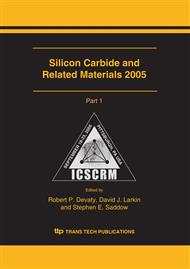p.227
p.231
p.235
p.239
p.243
p.247
p.251
p.255
p.259
Growth of Low Basal Plane Dislocation Density SiC Epitaxial Layers
Abstract:
A method was developed in our laboratory to grow low basal plane dislocation (BPD) density and BPD-free SiC epilayers. The key approach is to subject the SiC substrates to defect preferential etching, followed by conventional epitaxial growth. It was found that the creation of BPD etch pits on the substrates can greatly enhance the conversion of BPDs to threading edge dislocations (TEDs) during epitaxy, and thus low BPD density and BPD-free SiC epilayers are obtained. The reason why BPD etch pits can promote the above conversion is discussed. The SiC epilayer growth by this method is very promising in overcoming forward voltage drop degradation of SiC PiN diodes.
Info:
Periodical:
Pages:
243-246
Citation:
Online since:
October 2006
Authors:
Price:
Сopyright:
© 2006 Trans Tech Publications Ltd. All Rights Reserved
Share:
Citation:


